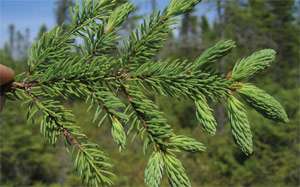
Bugwood.org
When temperatures linger around 60 degrees, most people reach for light jackets or flannel shirts; conversely, when the mercury hits 80, we don shorts and short sleeves. Seventy degrees? Well that’s just about the perfect
temperature, isn’t it?
It turns out we’re not alone in our admiration of the 70-degree mark. According to scientists at the University of Pennsylvania, trees around the world strive to maintain a near-constant temperature of 70 degrees in their leaves. This finding contradicts conventional wisdom that assumed leaf temperature mirrored that of the ambient air around it.
The discovery was completely unexpected. Suzanna Richter, a graduate student at the University of Pennsylvania, had been experimenting on a 45-million-year-old piece of wood. Richter hoped that by analyzing the wood’s chemistry she could learn more about the climate in which the tree grew. For comparison purposes, she gathered wood samples from 39 contemporary tree species, ranging from Caribbean pine to Canadian black spruce.
The experiment she was working on was a bust, but Brent Helliker, a professor of biology at the University of Pennsylvania, figured out a way to apply Richter’s data to a different experiment.
By comparing the oxygen isotope measurements from Richter’s wood samples to meteorological data obtained from nearby weather stations, Helliker and Richter found that all of the trees were photosynthesizing most efficiently when the leaves were about 70°F, regardless of whether the tree was growing in Calgary or Costa Rica. In a number of news stories that followed the discovery, Helliker called the finding “my first jaw-dropping moment as a scientist.”
So how does a tree cool itself off when it’s 90 degrees out? Actually, it’s not that different from how you and I might do it. “Trees release water to cool off,” said Richter, “sort of like the way we sweat. In humans, it’s called perspiration, and in trees, it’s called transpiration, but it’s accomplishing a similar thing.”
Richter suggests that another way trees cool off is by wilting their leaves. Think of tree leaves as little solar panels that adjust to maximize sun exposure. When a leaf wilts, the leaf angle drops so that it’s not getting direct sunlight.
Conversely, trees in colder climates have developed techniques for holding in heat. Richter says that Canadian spruce trees pack their needles tightly together so that cold wind passes around and over the groups of needles, not between them. “Brent [Helliker] likes to use the glove-and-mitten analogy,” said Richter. “If you think of the spruce needles as your fingers, you know that when they’re splayed out in a glove, they get colder than when they’re clumped together in a mitten.”
Perhaps aware that journalists have a habit of favoring the anthropomorphic qualities in a story like this over the isotopic oxygen part, Richter stresses that trees are not generating body heat like a mammal. Instead, a better analogy is probably a car engine. At a certain temperature, at a certain speed, a driver gets the smoothest performance and best gas efficiency out of a vehicle. With trees it’s sort of the same thing. Under some conditions, the
leaves will be hotter or colder than the optimum, no matter what the tree does, and then, although photosynthesis goes on, it isn’t as efficient.
“Seventy degrees is the temperature at which the leaves are most productive,” said Richter. “It’s their best work temperature; it’s when they’re taking in the most carbon.”
The finding will allow scientists to correct past models that assumed tight coupling between air and leaf temperature. In the future, the discovery may help scientists determine how the earth’s vegetation might respond to climate change.


Discussion *